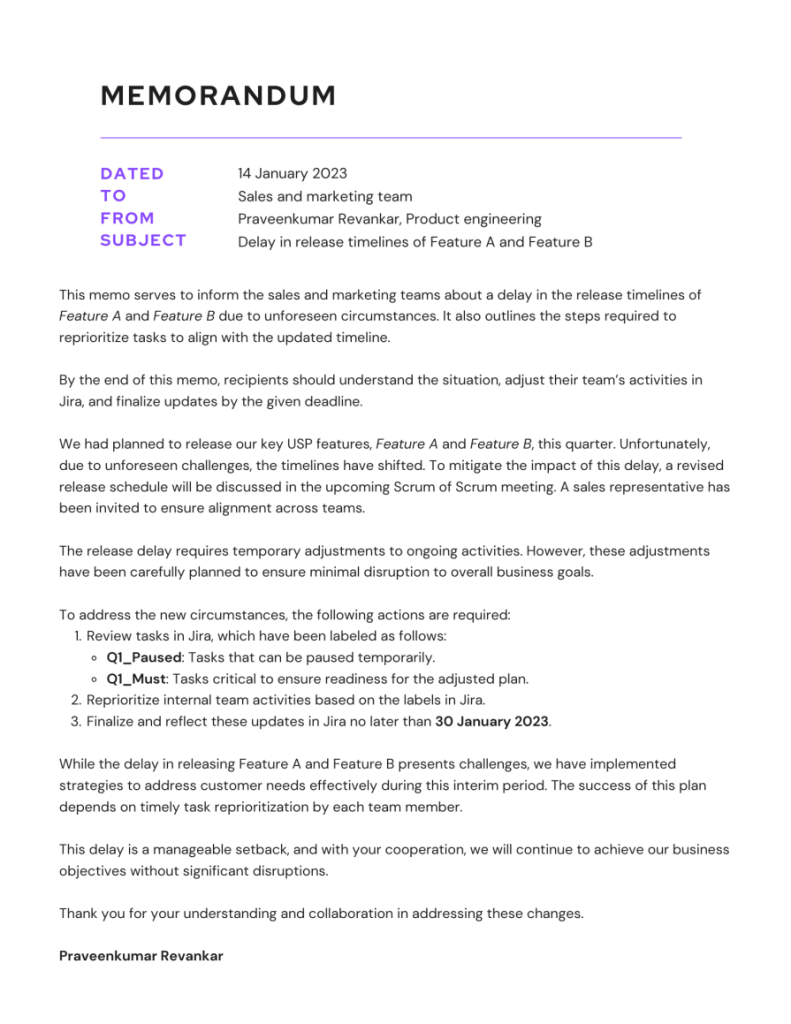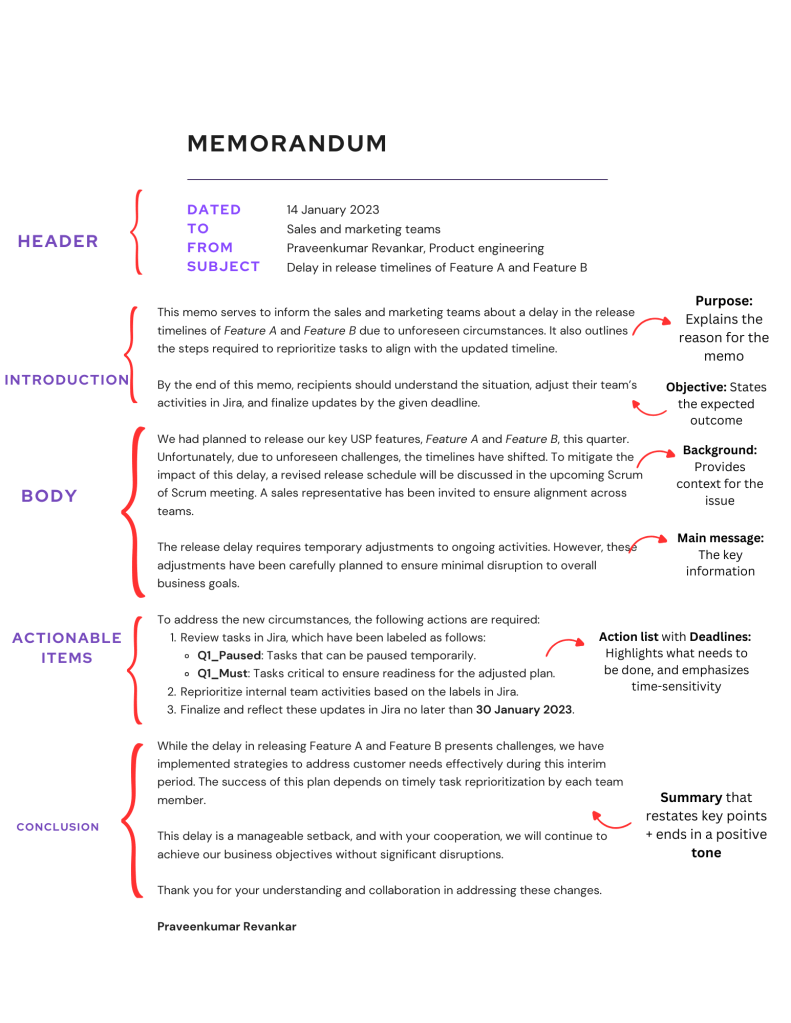Editor’s note — This post was last updated on December 26, 2024.

When you need to communicate with a colleague, boss, or team, how do you do it? The options are endless — phone calls, emails, texts, or even tools like Skype, Slack, and WhatsApp. You might even drop a sticky note at their desk!
All these ways fall under any of the two categories of communication — formal and informal. Informal communication, often referred to as casual communication, is great for quick exchanges. When it comes to formal communication, though, there’s one method that’s been around since the 1800s era of business — a memo.
A memo format provides a clear and structured way to convey important business information. But what is the format of a memo? Why is proper formatting so crucial when using a memo? How can effective formatting enhance your message?
In this post, I’ll talk about the memo format in detail. I’ll delineate essential formatting guidelines and share examples that’ll help you craft super professional and effective memos.
I’ve also built a downloadable memo template for you to leave this blog with.
A memo, short for “memorandum,” originates from the Latin word meaning “that which is to be remembered.” In the business world, memos are used to share messages that need to be retained and acted upon.
Memos are typically brief, formal documents shared with an internal group, designed to convey essential information and prompt action. They might include updates to operational processes, changes in company financial reimbursement policies, a delay in the project timeline, or even incident reports.
You see, all this information needs to be remembered by the audience you are sharing it with and needs to be acted upon accordingly. Unlike external legal documents like MOUs or MOAs, memos are mainly used for internal communication within organizations.
There are various types of memos, each tailored to specific purposes. Common examples include:
Knowing when to write a memo is key to mastering this business communication format. You should write a memo when:
You might be thinking, is this not why we have “for your information,” “for your reference,” or “for immediate action” emails that we send and receive?
A short thought for modern-day communication would be — yes.
But a memo has much more than that because it’s more formal.
Writing a memo isn’t just about the content; the format plays a critical role in ensuring that your message is clear, professional, and actionable.
Here’s a breakdown of the essential sections and formatting rules to create a well-structured memo:
The header is the first part of the memo. It sets the stage for your memo by providing key details upfront. It should include:
The introduction is a brief explanation of what we are about to cover in the memo. This is the most powerful part of a memo. It’ll set the tone and provide essential content. It should include:
The body is the core of your memo; it’s where you present the main message or content. To meet the target of clarity and conciseness, I recommend organizing the content into paragraphs or bullet points. The body should talk about:
If the memo requires the reader to take specific actions, outline them in a separate section.
Use clear and actionable language, highlight dates or important milestones, and assign responsibilities where applicable.
The conclusion section of the memo will tie it all up, and leave the reader with a clear takeaway. It should:
Here’s a downloadable memo template for you. It should serve as a strong starting point!
And, of course, a strong example will help you better understand memo formatting.
I’ll take an actual scenario and show how I translate it into a structured, effective memo.
The product engineering team is facing delays in the release of two key features. The team now needs to notify the sales and marketing teams about these delays, while providing guidance on reprioritizing tasks to align with the updated goals.


Even seasoned professionals can misstep when crafting memos. To ensure that the message in your memo lands where you want it to, you’ll need to steer clear of some common pitfalls. I’ll break them down for you:
Avoid writing subject lines that are either too generic or so detailed that they leave no reason to read further. “Policy update” is too vague, and “New HR policy on remote work including weekly reports, home office setup, and monthly check-ins” is a bit too much.
Fix — The best way forward is to craft concise, specific subject lines that summarize the memo’s purpose without giving everything away. Something like “Update on remote work policy: Key changes and actions needed” sounds ideal.
I see a lot of memos that fail to clearly state why the memo is being written at the start.
Without a clear purpose, readers may struggle to understand the memo’s relevance or intent.
Fix — I highly recommend that you open every memo with a straightforward purpose statement that answers why the reader should care. A good example is “This memo outlines adjustments to our remote work policy and highlights steps for transitioning to the new system.”
It’s a common mistake to jump straight to actions without providing the necessary background. This can confuse readers who lack the context to understand the situation.
Fix — It’s best to include a brief section explaining the situation. Make it concise but thorough enough to orient readers. Something like ““Following a company-wide survey, we identified key areas to improve flexibility and efficiency in remote work arrangements” does the job well.
Writing lengthy memos filled with unnecessary information or overly detailed narratives dilutes the main message and frustrates readers.
Fix — I prefer sticking to the essentials. State the problem, provide context, outline actions, and conclude. Easy. And use bullet points for lists and keep paragraphs brief (2–3 sentences).
Try not to present a memo with unclear sections, inconsistent spacing, or overly dense paragraphs.
Fix — Just use clear subheadings where needed. Use consistent fonts, margins, and spacing. And break up content with lists or bold text to emphasize key points like I did in my example.
Let’s not send the memo to individuals or teams who don’t need the information. And it’s even worse to be ignoring potential questions or concerns the audience might have after reading the memo.
Fix — One, ensure every recipient has a role or stake in the message. Avoid sending a company-wide memo about a team-specific process update. And two, anticipate objections and address them upfront. Say, you’re introducing stricter meeting policies. Ideally, you would explain how they’ll reduce workload and improve efficiency. This minimizes follow-ups and ensures clarity.
Ooh, and avoid misusing memos. Using memos for non-critical information or announcements that don’t require formal documentation — that’s not ideal. Don’t send a memo to share team-building activity schedules or congratulate an employee.
Use memos for critical communication where action or long-term reference is required. Save less formal updates for emails or other communication channels.
A memo format is structured and formal, typically including:
The correct order is:
Memos and letters differ in purpose and format:
While memos focus on sharing actionable information within an organization, letters are best for external correspondence.
Yes, Microsoft Word offers built-in memo templates. These templates include preformatted headers and sections, making it easy to craft a professional memo. Search “memo” in the template gallery to start.
A well-crafted memo is brief and to the point, often no longer than one page. Avoid overloading the memo with unnecessary details to keep the reader focused on the message and actions required.
Yes, memos are inherently formal, as they communicate critical information internally. However, the tone can vary slightly depending on the audience.
Absolutely! I highly recommend bullet points for the body section. They make information easier to read and ensure actionable items are clear and concise.
Let me summarize all of this discussion for you.
Writing a memo is all about clear, concise, and actionable communication. Start with a structured format — header, introduction, body, actionable items, and a strong conclusion.
Keep your tone professional but approachable, and make sure your memo leaves the reader with a clear understanding of the next steps.
Remember, a memo isn’t just a formality; it’s a tool to help teams take action and stay aligned. So next time you sit down to draft one, think about what your audience needs to know, what they need to do, and how you can make their lives easier by giving them all the right info in one place.
Now, go ahead — put these tips into action, and start crafting memos that get results!

LogRocket identifies friction points in the user experience so you can make informed decisions about product and design changes that must happen to hit your goals.
With LogRocket, you can understand the scope of the issues affecting your product and prioritize the changes that need to be made. LogRocket simplifies workflows by allowing Engineering, Product, UX, and Design teams to work from the same data as you, eliminating any confusion about what needs to be done.
Get your teams on the same page — try LogRocket today.
LogRocket's Galileo AI watches sessions and understands user feedback for you, automating the most time-intensive parts of your job and giving you more time to focus on great design.
See how design choices, interactions, and issues affect your users — get a demo of LogRocket today.

Most teams fail at autonomy. Learn how clear rules help product teams move faster without micromanagement.

A practical framework for PMs to use AI in ideation without sacrificing judgment, strategy, or decision quality.

A practical five minute revenue estimation method to help product managers compare ideas, drop low impact features, and prioritize smarter.

A practical guide for PMs who want to stop being bottlenecks, delegate smarter, and lead teams effectively with a clear ownership framework.
One Reply to "Memo format guide: How to write a memo with examples"
Please write a memo on an accident vehicle the total sum of 2550us but my company is asking to pay the money in four installment but how to write it help me